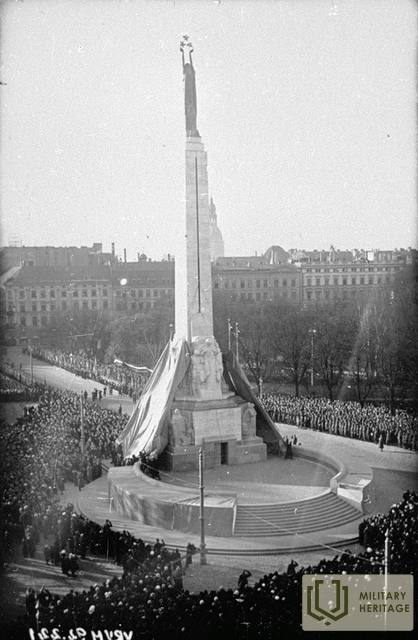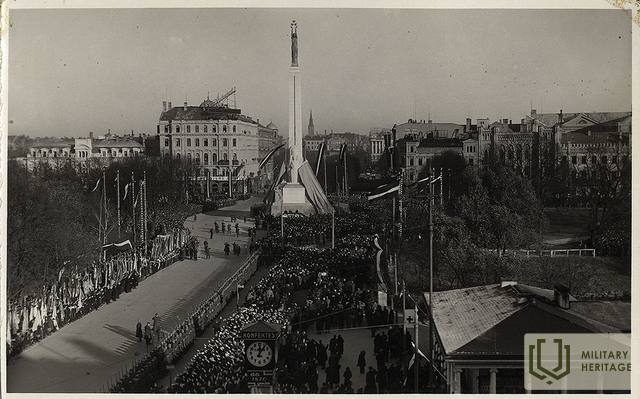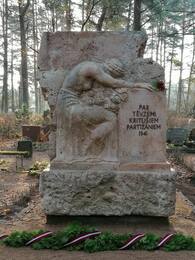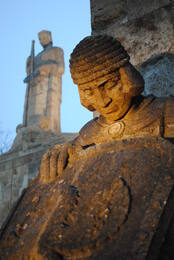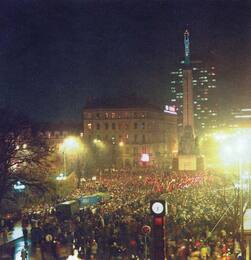Karlio salė ir Laisvės paminklas
Pasakotojas aprašo Kārlio Zāleso, kaip asmenybės, sukūrusios garsiausius Latvijos meno kūrinius, prisiminimus. Aprašymas skirtas Zāleso atminimui 1942 m. (K. Zāleso mirties metais). Prisiminimai buvo pasirinkti taip, kad apibūdintų K. Zāleso kūrybą, remiantis autoriaus asmeninėmis savybėmis ir pasaulio suvokimu.
„(..) Savo gyvenime ir kūryboje Zālės asmenybė vystėsi iš jo vidinio centro. Zālė yra vienas iš tų žmonių, kurie, jį sutikę, iš karto galėjo pajusti vidinę šerdį už išorės, kažką esminio. Ši šerdis buvo įaugusi į jo gyvybingumą. Įgimtos galios, kuršių protėvių palikimas, yra didysis kraitis, kurį Laima įdėjo į Kursos sūnaus lopšį. Gamta dosniai apdovanojo Zālę šiuo gyvybingumu. Neišsenkantis gyvybingumas tekėjo skulptoriaus laikysenoje, kiekviename geste, išraiškingame bruožų žaisme ir jo kalboje, suteikdamas viskam savotiško gaivumo ir sultingumo. Iš derlingo gyvybingo sluoksnio vikriai ir spontaniškai prasiveržė jo fantazija, išsiveržė gyva mintis. Iš čia kilo viskas, kas Zālės gyvenime ir kūryboje buvo originalu ir sveikai primityvu. Šis nesulaužomas kaimiškų jėgų lobynas skynėsi kelią per gyvenimą ir įveikė sunkumus. Meninėje kūryboje tai suteikė mums galimybę pasakyti kažką savo ir kažką naujo, išsiskirti pirmoje vietoje, pasiekti išskirtinių pasiekimų savo monumentaliojoje skulptūroje. Šiame meno regione,“ neturėjome savo tradicijų, kurios būtų išaugusios moderniosios kultūros rate, kuris Latvijos tapybos regione pradėjo formuotis nuo praėjusio amžiaus pabaigos. Taigi, galėjome gana lengvai pasiduoti senųjų kultūros tautų įtakai, likdami mėgdžiotojais ir palikuonimis. „Jei to nebūtų nutikę, jei per gana trumpą laiką mūsų geriausi monumentaliosios skulptūros skulptoriai sugebėjo sukurti kažką originalaus ir dėmesio verto, tai už tai turime dėkoti kaimiškam mūsų gyvenimo pamatui. Zālė šį senovinį sluoksnį išreiškia su giliu ir instinktyviu saugumu. Taigi moderniosios meninės raiškos formos galėjo išaugti iš kaimiškai gaivaus primityvumo šaknų, įžvelgdamos už dabartinės kultūros puošybos senovės išmintį ir grožį jos – norėtųsi sakyti – barbariškame spindesyje ir didybėje (..)“
„(..) Mes, – tarė meistras, – neturėtume gėdytis ir bėgti nuo savęs ir laiko, kuriame esame, o turėtume būti tokie, kokie esame – latvių menininkai. Jei esi menininkas, rodyk savo žemės galią, jos palaiminimus ir grožį, rodyk darbininkus jų pastangose, rodyk motiną, šeimos židinio saugotoją, tėvynės gynėją, visa tai rodyk su pagarba, su šiltais jausmais ir pagarbiu jausmu, kad kiti galėtų pamatyti, kas mes esame, ir mus gerbti. Bet jei savo nevykusiuose vaizdavimuose juos priversite atrodyti kaip luošus, jei valstiečių ir darbininkų veidus tepsite purvu, paversdami juos nebyliais gyvuliais, rodysite juos kreivus ir sulūžusius kaip vergus ar nusikaltėlius, – apšmeižėte ir spjaudėte ant savo žmonių. Toks kvailys turėtų geriau mesti teptukus ir eiti kasti griovių arba dirbti kokį nors kitą, naudingesnį darbą. Kaip kiti gali tave gerbti, jei nežinai, kaip gerbti save? Būti menininku nereiškia sklandyti gyvenimo išorėje ir atsitiktiniuose smulkmenose, bet reiškia ieškoti branduolio ir užuomazgos gamtoje ir žmonėse.“ Diletantai laikosi atsitiktinių smulkmenų ir nemato pagrindinio dalyko, o kiti diletantai žaidžia su forma ir džiaugiasi tarsi laimingais atsitiktinumais. Jei aš spjaudžiu, mano seilė kartais išsilieja su kažkokiais posūkiais ir lašais, bet ar taip turėtų elgtis rimtas menininkas? Taip elgiasi tik mėgėjai niekšai, kurie demonstruoja kiekvieną savo kvailumą, bet ne rimti tapytojai. Žinovas ir diletantas – tai buvo kartūs ir paniekinantys žodžiai Zālės lūpose. Skulptorius taip pat negerbė lengvos improvizacijos ir tuščio entuziazmo mene. Ypač paskutiniame savo gyvenimo etape Zālė vis labiau pabrėžė žinių ir tikrųjų gebėjimų, įgūdžių ir meistriškumo svarbą. Jis labai gerbė akademinio meno tradicijas. Kartą, Brolių kapų komiteto posėdyje, skulptorius paneigė akademiko F. prieštaravimus, kad jo sukurti arklių stovai nebuvo teisingų proporcijų. Tada Zālė liepė atnešti skriestuvą ir, išmatavusi, parodė, kad viskas atitinka pripažintas normas. F. vėliau jautėsi visiškai nejaukiai. Pamenu, kad rodydamas darbų nuotraukas... Liuksemburgo muziejuje vykusiame akademinių meistrų pagerbime Zāle džiūgavo: „Kokios čia žinios ir įgūdžiai! Iš karto aišku, ko meistras norėjo pasiekti. Čia yra proporcijos, formų formavimo supratimas, grožio pojūtis. Tokie darbai visada išlaikys savo vertę ir nepavargs. Tačiau kai kurie geri žmonės, dėl savo mėgėjiško nekompetencijos ir nepasiruošimo, įsivaizduoja, kad kuria puikius meno kūrinius.“ (..)
„(..) Viena vertus, Zāle susitelkė į rimtus formos tyrimus, judėjimo ir anatominės struktūros supratimą, tačiau, kita vertus, kompoziciją iškėlė į savo darbo centrą. Studentams, kurie jau įsivaizdavo save kaip paruoštus menininkus, kuriems leidžiama daryti, ką jie nori, Zāle tiesiog pasakė, kad negaištų laiko čia, akademijoje. Akademijoje reikia mokytis skulptūros amato, įgyti žinių, įgūdžių. Namuose galima daryti tai, kas patinka ir kas ateina į galvą. Su dideliu entuziazmu profesorius Zāle mokėjo prieiti prie studentų, neslopinant jų individualaus suvokimo, bet paaiškinant, ką reikia daryti ir kaip spręsti savo užduotį. Daugeliui čia pirmą kartą atsivėrė akys, o palankūs rezultatai jau per trumpą laiką buvo matomi studentų darbų parodoje. Zāle privertė juos giliau pasinerti į kompozicijos prasmę, formų struktūrą, judėjimą, figūrų raišką ir charakteristikas. Kai studentas suprato, ką galima rasti tam tikroje kompozicijoje, ir griežtas natūralių formų tyrimas įgavo visiškai kitokią prasmę. Taigi jis...“ mokė savo mokinius sąmoningai valdyti savo kūrinius, o ne tiesiog beprasmiškai kopijuoti gamtos vaizdą (..)“
„(..) Jis dalyvavo Laisvės paminklo projektavimo konkurse 1924 ir 1925 metais. 1925 metais Ministrų kabinetas nusprendė, kad Laisvės paminklas turėtų būti statomas pagal Zalės projektą, tačiau šis sprendimas nebuvo įgyvendintas. Tais metais dėl šių reikalų daug kas vyko, intrigos ir triukšmas, tačiau jokio konkretaus teigiamo rezultato nebuvo. Tačiau konkursas, kaip ir darbas Brolių kapinėse, buvo svarbus Zalės plėtrai. Jis įgijo didelę patirtį, turėjo daug ką apsvarstyti ir apmąstyti, išgryninti savo idėjas, kurias vėliau galėjo įgyvendinti praktiškai. Meistras ir kai kurie artimiausi jo draugai turėjo savo susitikimų vietą mieste – pas Maderniekus, Brīvības gatvėje 13. Čia rinkdavosi ir bendradarbiai, nes tai buvo šios menininkų asociacijos rezidencija. Ten jie išsamiai aptardavo dienos įvykius ir meno klausimus; jie parašydavo arba aptardavo keletą gerų straipsnių. Buvo „durnių“, kuriuose jie aptardavo paminklo projektavimo konkurso metu susidariusią situaciją, džiaugdamiesi savo sėkmėmis ir džiūgaudami dėl nesėkmių. Zalė taip pat Tais metais jis gana aktyviai dalyvavo kooperatyvo veikloje. Jo minčių visada atidžiai klausydavosi tiek vyresni, tiek jaunesni grupės menininkai. Iki 1930 m. Laisvės paminklo klausimas buvo atidėtas. Kai žymūs valstybės ir visuomenės veikėjai vėl su nauja energija ėmėsi šio klausimo, buvo rastas reikiamas sprendimas. 1930 m. įvyko paskutinis paminklo projektų konkursas, kuriame Zāle laimėjo pirmąją vietą. Šis projektas buvo patobulintas ir, bendradarbiaujant su arch. Štālbergu, buvo baigtas per 4 metus. Tuo metu paminklo aikštėje iškilo aukšta kareivinė – dirbtuvės su šviesiais langais. Statomas darbas pamažu augo savo šerdyje. Zāle gamino modelius moderniai įrengtose naujose dirbtuvėse Polocko gatvėje, čia vyko akmens kalimas. Stulpai ir laiptai aplink paminklo šerdį vedė nuo grindų iki grindų; Daugelio akmentašių ir meistrų padėjėjų kaltai skambėjo ant žemės ir platformų. Pneumatiniai kaltai riaumojo, draskydami tvirtą granito masę. Tai buvo tarsi keista pasakų šalis, kur... kūrėjo valia privertė dvasioje matomas formas nugrimzti ir pasilikti materijoje. Saulės šviesa plūdo į plačių erdvių prieblandą, ir joje mirgėjo balti milžinų tribūnos, kiekviena tyliai iškilmingai laukdama savo išsipildymo akimirkos. Aplinkui gulėjo išsibarstę akmens luitai su jau pradėtomis dalimis: rankomis, juosmenimis, galvomis, tikrai membrana disiecta – kaip sako lotynų poetas. Šie įspūdžiai neišdildomai išliko dirbtuvių lankytojų atmintyje. Laisvės paminklas buvo baigtas. Tuo tarpu Zāle įsigijo namą Avotu gatvėje. Jo pajamos turėjo užtikrinti meistro ir jo šeimos egzistavimą, kad jie ateityje galėtų gyventi ir dirbti savarankiškai, nes menininko ketinimai buvo turtingi ir platūs (..).
„(..) Praeitis ir dabartis, tarsi viena nedaloma daina, telpa herojiško epo garsuose Laisvės paminkle. Vienu dideliu atodūsiu ji išreiškia visą žmonių gyvenimą: darbą, dvasines paieškas, šeimą, karinę jėgą; Lāčplēsis – laukinių jėgų atlikėjas, dainų autorius; vergijos pančių sulaužytojai ir Laisvės vaizdas su trimis spindinčiomis žvaigždėmis, atsiveria ir istorinės scenos. Čia visur šviečia nuostabi pasakų šviesa. Tą patį perteikia ir daugelis kitų pastarųjų metų Zālės kūrinių. Čia meistras ieško esmės realybės vaizduose ir pačią realybę pakelia iki iškilmingo ir paprasto pasakos grožio (..)“
laikraštis “Latvju Mēnešraksts”, Nr.5. 1942. Straipsnio pavadinimas “Kārlis Zāle”
Susijusi laiko juosta
Susijusios vietos
Paminklas „Sėdinčiai motinai“ Inčukalno garbės kapinėse
Yra: Inčukalno savivaldybė, Inčukalns, Miera gatvė, Inčukalno kapinės.
Paminklas atidengtas: 1944 m. liepos 16 d. Paminklas atidengtas po K. Zālės mirties. Užrašas: Žuvusiems Tėvynės partizanams 1941 m. (atkurtas). Paminklas restauruotas 2020 m. lapkričio 5 d. Paminklas restauruotas remiant Inčukalno regioninei tarybai. Restauratorius menininkas Igoris Dobičinas.
Įvykiai: „1940 m. birželio 17 d. Latviją okupavo SSRS. 1941 m. birželio 14 d. buvo vykdomos trėmimai. 1941 m. birželio 22 d. Vokietija užpuolė SSRS, ir Vermachto daliniai įžengė į Latviją. Raudonoji armija ir jos rėmėjai atsitraukė. Daugelyje Latvijos vietų – įskaitant Raganą, Sėją ir Inčukalną – buvę sargybiniai ir patriotiškai nusiteikęs jaunimas organizavosi ginti savo namų ir skubėti išvyti sovietų okupantus. Kai 1941 m. liepos 1 d. Sėjos valsčiaus „Ziediņi“ (Gėlės) rajone vėl buvo iškelta Latvijos Laisvosios Valstybės vėliava, specialieji Raudonosios armijos daliniai Šiaurinėse kapinėse sušaudė šio namo savininkę – 39 metų Elzą Višą, o Sėjos ir Krimuldos valsčių pasienyje – jos motiną – 64 metų Elzą Martinovą. Tai sukėlė dar daugiau neapykantos ir pasipiktinimo tarp vietovės gyventojų, ir jie pradėjo...“ susiburti į liaudies pasipriešinimo judėjimą ir kurti savigynos būrius, kurie dar buvo vadinami pirmaisiais partizanais (Inčukalno grupės vadas buvo Maksis Cālītis). Prie regiono kovotojų prisijungė ir iš Litenės karinės stovyklos pabėgę arba paleisti vadinamojo Latvijos teritorinio korpuso kareiviai bei karininkai. Po kelių dienų, liepos 4 d., įvyko ginkluotas susidūrimas su raudonaisiais, mūšyje žuvo septyni kareiviai ir Raganos vaistininko sūnus Pēteris Prašķēvičs. Be to, Raganos mūšyje buvo sužeistas ir paimtas į nelaisvę 17 metų Rėzeknės mokytojų instituto studentas Jānis Porietis, kuris buvo kankinamas, sušaudytas ir palaidotas netoli Straupės.
Čia, Inčukalnyje, buvo iškastas bendras brolių kapas, į kurį aštuoniais arklių traukiamais vežimais po vieną buvo vežami iš baltų neobliuotų lentų pagaminti karstai, kad žuvę didvyriai galėtų ilsėtis gimtojoje žemėje. Po kelių mėnesių, jau vokiečių okupacijos metu, kapinėse buvo įrengtas Kārlio Zāleso (nuo 1939 m. iki gyvenimo pabaigos 1942 m. vasario 19 d., dėl sunkios ligos genialusis latvių skulptorius pasirinko Inčukalną savo gyvenamąja vieta) suprojektuotas paminklas – sielvartaujančios motinos ant rožių kelių atvaizdas. 1950-aisiais vietos komunistų aktyvistai paminklą susprogdino. Paminklas apgadintas ir nejudantis gulėjo iki pat Atgimimo, kai 1980-ųjų pabaigoje vis daugiau žmonių susidomėjo ir kalbėjo apie 1941 m. liepos 4 d. įvykius bei ragino restauruoti Kārlio Zāleso paminklą. Šis reikalavimas buvo išsakytas 1988 m. rugsėjo 8 d. Inčukalno pradinėje mokykloje sušauktame žmonių ir valdžios susirinkime, kuriame dalyvavo ne tik Inčukalno gyventojai, bet ir netoliese esančių parapijų gyventojai, taip pat Aplinkos apsaugos klubo ir Latvijos nacionalinės komunistų sąjungos nariai iš Rygos.
... Paminklo restauravimo darbuose aktyviai dalyvavo Inčukalno gyventojai – Teodors Ildens, Arvīds Blaus, Pēteris Vorfolomējevs, ... ir daugelis kitų patriotiškai nusiteikusių žmonių. 1989 m. liepos 4 d. naujai atgimęs kilnus ir liūdnas paminklas buvo iškilmingai pašventintas kunigo Vairos Bitēnas.“
Brolių kapinės Rygoje
Rygos brolių kapinės yra šiauriniame Rygos rajone. Kapinės užima 9 ha plotą ir yra iškiliausias bei reikšmingiausias memorialinis ansamblis Latvijoje, skirtas žuvusiems Latvijos kariams. Čia palaidota apie 3000 karių. Brolių kapinės buvo įkurtos Pirmojo pasaulinio karo metu, palaidojus pirmuosius tris Latvijos šaulius, žuvusius Tyrelio purve mūšyje prieš vokiečių armiją. Vėliau Brolių kapinėse taip pat buvo palaidoti Latvijos kariai, žuvę kituose mūšiuose ir karuose. Memorialas sukurtas pagal skulptoriaus Kārlio Zālės projektą ir yra pirmasis memorialinis ansamblis Europoje, turintis tokią kraštovaizdžio, architektūros ir skulptūrinę vertę. Jame naudojami Latvijos kraštovaizdžiui būdingi elementai, tradicinės sodybos, Latvijos folkloras ir istorija, kurie giria karių savybes ir pasakoja apie kario kelią. Memorialas buvo atidengtas 1936 m. ir jį sudaro trys dalys: „Minties kelias“ – 250 m ilgio alėja, „Didvyrių terasa“ su Šventosios liepsnos aukuru ir Šventosios ąžuolyno ansambliu bei laidojimo vieta su Latvijos siena ir motinos su žuvusiais sūnumis memorialu.
Laisvės paminklas Rygoje
Laisvės paminklas buvo vienas iš centrinių simbolinių Atgimimo įvykių taškų. 1987 m. birželio 14 d. žmogaus teisių grupė „Helsinki-86“ surengė nesankcionuotą viešą gėlių padėjimo ceremoniją prie Laisvės paminklo. Po dviejų mėnesių, rugpjūčio 23 d., „Helsinki-86“ paragino surengti mitingą prie Laisvės paminklo, minint 48-ąsias Hitlerio ir Stalino pakto, pasirašyto 1939 m. rugpjūčio 23 d., metines. Šio mitingo metu sovietų policija sumušė ir suėmė demonstrantus. Vėlesniais metais gėlių padėjimo ceremonijos prie Laisvės paminklo tapo visų didesnių demonstracijų ir kitų masinių renginių dalimi.
Įsikūręs Rygos centre, Laisvės aikštėje.
Laisvės paminklas yra vienas iškiliausių Latvijos istorijos, architektūros ir meno paminklų. Pastatytas pagal Kārlio Zālės projektą visuomenės aukomis. Jis buvo atidengtas 1935 m. kaip Latvijos žmonių laisvės ir meilės tėvynei simbolis. Kartu su Rygos brolių kapinių ansambliu jis yra vienas vertingiausių monumentaliosios architektūros ir skulptūros pavyzdžių.
Laisvės paminklas išreiškia Latvijos kultūros etines ir estetines vertybes. Simboliai atspindi filosofinę laisvės esmę ir Latvijos tautos istorines idėjas apie kovos už nepriklausomybę etapus. Jie nurodo į fizinės ir dvasinės stiprybės įsikūnijimą. Herojiška kalba pasakoja apie Latvijos žmones kaip savarankiškus, aktyvius istorijos kūrėjus ir savo likimo lėmėjus.
Jo vietoje iš pradžių stovėjo paminklas Rusijos carui Petrui I. Pirmojo pasaulinio karo metu jis buvo išardytas ir laivu nugabentas į Petrogradą. Laivą torpedavo vokiečių povandeninis laivas, ir jis nuskendo prie Estijos Vormsi salos. Sovietų okupacinis režimas kelis kartus planavo nugriauti Laisvės paminklą, tačiau to neįvyko.
Šiandien galite pamatyti vieną iš Latvijos simbolių ir stebėti kariuomenės garbės sargybos tradicijas.
Ant kanalo kranto, šalia Laisvės paminklo, sukurtas taktilinis Laisvės paminklas. Šią ypatingą bronzinę miniatiūrą 1:50 masteliu sukūrė skulptorius Ivaras Miķelsonsas.




